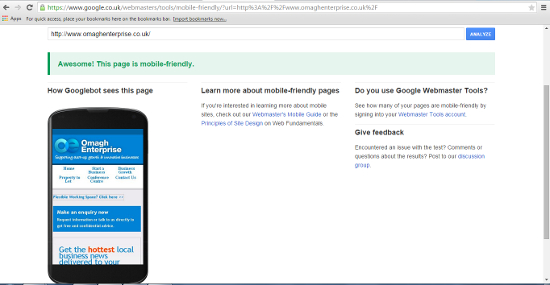Is Your Google Ranking Falling Off? Take The Mobile-Friendly Test.
If your website doesn’t pass Google‘s mobile-friendly test, it will slide right down the pages. So instead of being on the all-important page one of search results, you’ll be on page 27. Which is really popular.
Its new Google algorithm, which was introduced on April 21, favours websites with large text, links that are easy to find and navigate, and a design that resizes to fit whatever screen it’s viewed on, be that a laptop, phone or tablet.
You might think it’s not as important for business to business sites to be consumer friendly. But what about a site specifically set up to be a user friendly interface? Say, for example, the official information site of the EU? Nope, not mobile friendly.
Or a site that specifically targets online users and encourages a digital selling process, such as, for example, Ryanair‘s website?
Also not mobile friendly.
What about smaller business? How ready are we for this new system?
Emma O’Connor is a full-time finance administrator, but she spotted a gap in the market in 2014, and started her first online business. “I set up Scene Designs after I grew tired of searching for high-quality, modern LGBT greeting cards,” she says, and developed her website with Kerry company Avalanche Designs.
“Scene Designs has a brilliant mobile-compatible site, but so do other sites. Catering for a small enough market, people do have to search for LGBT products online. Our website traffic has trebled in the last month. Could this be due to Google’s change? Absolutely.”
Rachel Murphy of NP Liquid Glass Systems has noticed a definite increase in online traffic in the last few weeks. They have spent a lot of time since 2014 making sure their website is mobile friendly.
Because their service is very visual, using a lot of photos and videos to demonstrate how Liquid Glass works, she understands that if the content isn’t easily viewed on a mobile device people tend to move on to the next website.
While DIY template website builders such as SiteBuilder, Weebly and Wix all offer ‘drag and drop’ design and editing process for creating your own mobile friendly websites, professional web design companies have been aware of the coming changes for a long time, and work mobile friendly elements into every design.
Business development manager Amit Wadhwa of Xava says: “There are multiple challenges in creating truly mobile optimised websites due to the vast variety of screen sizes and types in production today. Add to that the fact that 80pc of web traffic is mobile.
“It is vital to test the site properly. Furthermore, the various mobile browsers add to the complexity mix and as website developers, we need to test the maximum number of platform/screen size combinations for maximum coverage.
Amit says running a mobile site, in theory, does not present many challenges; if the designs have been implemented properly it should be self-supporting platform.
Graphic designer Una Healy of Una Healy Design says they were concerned when they found out about the upcoming changes, and amended their website to be completely responsive when viewed on mobile devices. It paid off. She has noticed the algorithm change “has upped us slightly to positions three to five on page one of Google, and sometimes higher.”
So go to Google’s mobile-friendly testing tool and check. If your site can’t be viewed easily and clearly on mobile devices, you’re not only risking alienation of customers, you’re now being treated as a second-class business by the world’s most important search engine.
Source: belfasttelegraph.co.uk
So Omagh Enterprise decided to put our site omaghenterprise.co.uk through the test. It’s only fair! Here is our result below.





